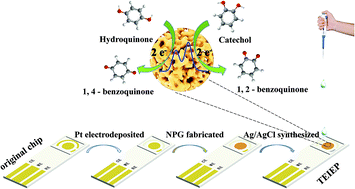A three-electrode integrated electrochemical platform based on nanoporous gold for the simultaneous determination of hydroquinone and catechol with high selectivity†
Abstract
In this study, a novel three-electrode integrated electrochemical platform (TEIEP) has been designed and fabricated for the simultaneous detection of hydroquinone (HQ) and catechol (CC), in which nanoporous gold (NPG) served as the working electrode, and Pt particles and nanoporous Ag/AgCl served as the courter electrode and the reference electrode, respectively. Due to the remarkable catalytic activity of NPG, the TEIEP exhibits high selectivity and sensitivity towards HQ and CC determination with a distinct separation between the peaks for their coexistence. The oxidation peak current densities of HQ and CC were linear over the range of 0.2–100 μM with the detection limits of 0.083 μM (S/N = 3) for HQ and 0.119 μM (S/N = 3) for CC. Moreover, TEIEP has a satisfactory reproducibility and anti-interference ability, and can be used in real water sample analysis. This work undoubtedly provides a remarkable choice for catalytic materials and an integrated structure, and further a promising application prospect for developing novel sensors for on-site environmental monitoring.



 Please wait while we load your content...
Please wait while we load your content...